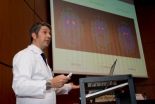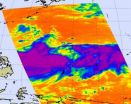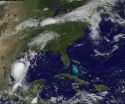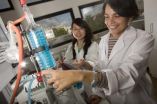(Press-News.org) SANTA CRUZ, CA--Although high-temperature superconductors are widely used in technologies such as MRI machines, explaining the unusual properties of these materials remains an unsolved problem for theoretical physicists. Major progress in this important field has now been reported by physicists at the University of California, Santa Cruz, in a pair of papers published back-to-back in the July 29 issue of Physical Review Letters.
The first paper, by UCSC physicist Sriram Shastry, presents a new theory of "Extremely Correlated Fermi Liquids." The second paper compares calculations based on this theory to experimental data from studies of high-temperature superconductors using a technique called angle-resolved photoemission spectroscopy (ARPES). The lead author of this second paper is Gey-Hong Gweon, assistant professor of physics at UC Santa Cruz, with coauthors Shastry and Genda Gu of Brookhaven National Laboratory.
"I showed my preliminary calculations to Gweon, who is an expert in this field, and he was very excited," said Shastry, a distinguished professor of physics at UCSC. "He obtained data from lots of experimental groups, including his own, and we found a remarkably successful agreement between theory and experiment at a level that has never been achieved before in this field."
Shastry's theory provides a new technique to calculate from first principles the mathematical functions related to the behavior of electrons in a high-temperature superconductor. Interactions between electrons, which behave as almost free particles in normal metals, are a key factor in superconductivity, and these electron-electron interactions or correlations are directly encoded in photoemission spectra.
Photoemission spectroscopy is based on the photoelectric effect, in which a material emits electrons as a result of energy absorbed from light shining on the surface of the material. ARPES studies, which produce a spectrum or "line shape" providing clues to the fundamental properties of the material, have yielded anomalous results for high-temperature superconductors.
"The unusual 'fatness' of the line shapes observed in electron spectroscopy has been at the center of the mystery of high-temperature superconductors," Gweon said. "The anomalously broad and asymmetric line shape has been taken as a key signature of strong electron-electron interaction."
Shastry's theory of extremely correlated Fermi liquids is an alternative to the Landau Fermi liquid theory, which is a highly successful model for the weakly interacting electrons in a normal metal but not for very strongly correlated systems. The success of Shastry's calculations indicates that the anomalous photoemission spectra of high-temperature superconductors are driven by extreme correlations of electrons. Shastry coined the term "extreme correlation" to describe systems in which certain "energy expensive" configurations of electrons are prohibited. This arises mathematically from sending one of the variables, known as the Hubbard "U" energy, to infinity.
"That leaves you with a problem that is very hard to solve," Shastry said. "I have been studying these problems since 1984, and now I have found a scheme that gives us a road through the impasse. The spectacular correspondence with the experimental data tells us that we are on the right track."
The experimental data come from ARPES studies using two different sources of light: high-energy light from synchrotron sources and lower-energy laser sources. In studies of high-temperature superconductors, these two light sources yield significantly different photoemission spectra for the same samples, and researchers have been unable to resolve this inconsistency. But Gweon and Shastry found that these apparently irreconcilable results can be accounted for by the same theoretical functions, with a simple change in one parameter.
"We can fit both laser and synchrotron data with absolute precision, which suggests that the two techniques are consistent with each other," Shastry said. "They are telling two different slices of the same physical result."
Shastry said he plans to use the new technique to calculate other experimentally observed phenomena. "There is still a lot of work to be done," he said. "We have to look at a variety of other things, and extend the new scheme to do other calculations. But we have made a breach through the impasse, and that's why we are excited."
###
Funding for this work was provided by the U.S. Department of Energy.
END
Patients suffering REM sleep behaviour disorders dream nightmares in which they are attacked and pursued, with the particularity that they express them by screaming, crying, punching and kicking while sleeping. Lancet Neurology has published the third consecutive work in five years about the relationship between this disorder and Parkinson's disease. The first work showed in 2006 that 45% of patients who suffer this sleep disorder develop Parkinson's disease and other neurodegenerative diseases caused by a lack of dopamine in the brain. The second article discovered that ...
PHILADELPHIA — Even in trace quantities, the radioactive gas radon is very dangerous; it is second only to cigarette smoking as a cause of lung cancer deaths in the United States. The expense and precautions necessary to study it safely have limited research into its properties. Now, University of Pennsylvania chemists have for the first time measured how well radon binds to a molecule, paving the way for future research on it and other noble gasses.
The research was led by associate professor Ivan J. Dmochowski, along with undergraduate Vagelos Scholar David R. ...
The width of an image from the AIRS instrument that flies on NASA's Aqua satellite is about 1700 km (1056 miles), and the clouds and thunderstorms associate with Tropical Storm Muifa take up that entire distance on today's imagery.
Tropical Storm Muifa is spinning through the western North Pacific Ocean today and has grown in size. When NASA's Aqua satellite passed over the storm on July 29, 2011 at 04:17 UTC (12:17 a.m. EDT) it measured the temperatures in the cloud tops. Those cloud top temperatures especially in the east and western sides of the tropical storm were ...
NASA is analyzing Tropical Storm Don from all angles, inside and out, using three different satellites. Don is expected to make landfall in southeastern Texas tonight or early Saturday.
NASA's Aqua satellite passed over Tropical Storm Don at 8:17 UTC (4:17 a.m. EDT) on July 29. The instrument called the Atmospheric Infrared Sounder (AIRS) took the temperature of Don's clouds in an infrared image. AIRS data revealed a large area of powerful, high thunderstorms with cold cloud tops surrounding Don's center where cloud temperatures were colder than -63 Fahrenheit (-52 Celsius). ...
The following highlights summarize research papers that have been
recently published in Geophysical Research Letters (GRL); Space
Weather; Geochemistry, Geophysics, Geosystems (G-Cubed); Journal of Geophysical Research-Biogeosciences (JGR-G); Journal of Geophysical Research-Earth Surface (JGR-F); Journal of Geophysical Research-Space Physics (JGR-A) and Water Resources Research (WRR).
In this release:
What do sea measurements reveal about Earth's temperature trend?
Japan's big earthquake shook the ionosphere
Miniature detector measures deep space radiation
New ...
Replacing gasoline and diesel with plant-based bio fuels is crucial to curb climate change. But there are several ways to transform crops to fuel, and some of the methods result in bio fuels that are harmful to health as well as nature.
Now a study from the University of Copenhagen shows that it is possible to predict just how toxic the fuel will become without producing a single drop. This promises cheaper, faster and above all safer development of alternatives to fossil fuel.
Solvejg Jorgensen is a computational chemist at the Department of Chemistry in Copenhagen. ...
Physicists at Forschungszentrum Jülich and the universities of Kiel and Hamburg are the first to discover a regular lattice of stable magnetic skyrmions – radial spiral structures made up of atomic-scale spins – on a surface instead of in bulk materials. Such tiny formations could one day form the basis of a new generation of smaller and more efficient data storage units in the field of information technology. The scientists discovered the magnetic spirals, each made up of just 15 atoms, in a one-atomic-layer of iron on iridium. They present their results in the current ...
A new national collaboration of asthma genetics researchers has revealed a novel gene associated with the disease in African-Americans, according to a new scientific report.
By pooling data from nine independent research groups looking for genes associated with asthma, the newly-created EVE Consortium identified a novel gene association specific to populations of African descent. In addition, the new study confirmed the significance of four gene associations recently reported by a European asthma genetics study.
The findings, published in Nature Genetics, are a promising ...
In this month's edition of Physics World, Richard Taylor, director of the Materials Science Institute at the University of Oregon, takes a serious, objective look at a topic that critics might claim is beyond scientific understanding – crop circles.
As the global crop-circle phenomenon grows alongside advances in science and technology, Taylor notes how physics and the arts are coming together to produce more impressive and spectacular crop-circle patterns that still manage to maintain their mystery.
Today's crop-circle designs are more complex than ever, with some ...
Scientists on the Norwich Research Park, working with colleagues in China, have developed new techniques that will aid the application of genomics to breeding the improved varieties of crop needed to ensure food security in the future. By dissecting the complicated genome of oilseed rape they have been able to produce maps of the genome that are needed for predictive breeding.
Traditional breeding involves crossing two varieties and selecting the best performing among the progeny. Predictive breeding is a more advanced technique where specific parts of the genome most ...




